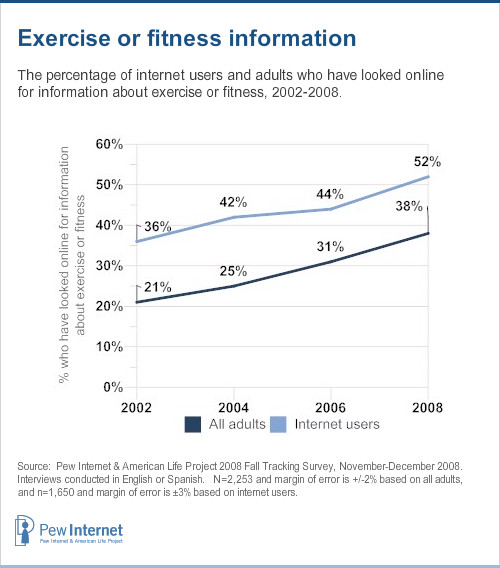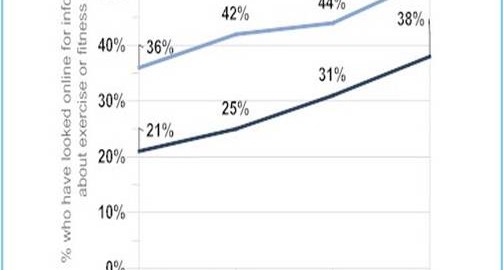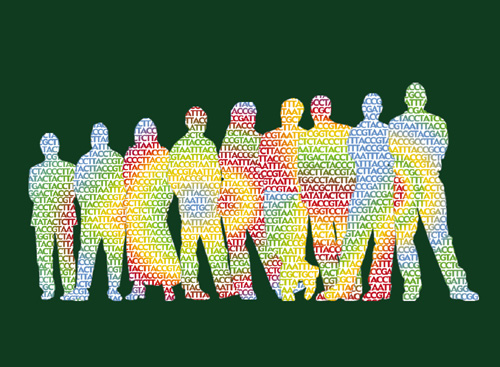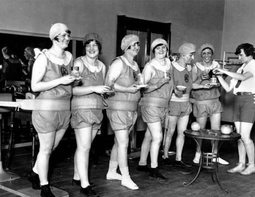Americans Jump Online for Exercise Information

More than half of all American adult internet users have looked online for exercise or fitness information, according to a new Pew report, The Social Life of Health Information. As shown in the graph above, that’s an astounding 38% of all American adults. The Pew Internet/California Healthcare Foundation survey, authored by Susannah Fox and Sydney Jones, queried over 2,250 adults by both landline and cell phone.
This sizable percentage of internet users that went strolling for clues to burn calories represents a whopping 88% increase from the percentage that went online for exercise information in 2002, which is the greatest increase over time of any topic covered in the survey. Perhaps most astounding,
More Americans looked online for information about exercise and fitness than for information about prescription or over-the-counter drugs, doctors, or hospitals.
The extensive data presented in this report are exciting and thought-provoking:
- 86% of respondents reported turning to health professionals for information or assistance in dealing with health or medical issues. Thus even in the age of the internet, Americans turn to the traditional white coat when it comes to their health. This speaks volumes about the importance of the Exercise is Medicine Initiative which encourages white-coated health care providers to include exercise when designing treatment plans for patients.
- Individuals who go online for health information often seek out user-generated content, or what’s referred to as “just-in-time someone-like-me.” However, few online individuals actually engage through creating content or participating on social network sites (e.g., Facebook, Twitter) for health queries and updates. In fitness terms, it appears individuals are seeking a virtual workout buddy, but then tend to hang out at the water fountain rather than actually break a virtual sweat. These data imply that when it comes to participation, the real world trumps the virtual world. While someone can easily just lurk in a virtual exercise community, in the real world a workout buddy would never let you just sit around.
- Almost half (49%) of individuals who look online for health information say their most recent search changed the way they think about diet, exercise, or stress management. Given the preponderance of lifestyle-related conditions such as heart disease and type 2 diabetes, it’s clear we need to not only change how people think about diet and exercise, we need to change what they do.
- While 83% of internet users go online for health information, 81% report they go online and do something related to health less often than once a week. This is not surprising, since for those who are healthy there’s little enticement to routinely click a mouse or tap keys to log minutes or steps walked. It will be interesting to see how these numbers change with increased availability of mobile technologies whereby individuals can automatically track laps while running on a track.
Overall, this report is great news for those of us in the health and wellness field. And in a wonderful coincidence, just days after these data were released about 250 of us met at the National Physical Activity Plan Conference in Washington, D.C. to draft the United States’ first comprehensive national plan, which follows the release of the first ever Physical Activity Guidelines for Americans by the federal government.
This new Pew report highlights the road that lies ahead. Many Americans are aware of the benefits of physical activity and are actively searching to learn more, both on- and off-line. Our challenge as health professionals is in getting Americans to let more than their fingers do the walking.
Great analyses of the Pew Report that offer food for thought:












This is great stuff Carol – I agree that many of the ‘record your progress’ sites and tools are useful in the short term but after the individuals truly does get active, it gets harder to see the usefulness.
I love how the Pew information can be used for such a wide range of insightful thinking. Also refreshing to learn about the initiative to get exercise into physicians’ recommendations. Public health is all about prevention over medication.
Susannah – Thank you so much for the outstanding report. You were exactly spot on to include the fitness data in the context of the other data, as it really showcases the relative impact. Do you have more unpublished tidbits on exercise? Your report left me hungry for info such as: Of the folks that go online for fitness/exercise info, what are they looking for? Are they finding it? Are they already active and looking for marathon training advice, or are they sedentary and looking for help to get off the couch? Do they become more active as a result of the information they find?
Andre – In terms of mobile technology, you, Susannah and I are on the same wave length. How can we play to the strengths of mobile to encourage folks to start and stay mobile? In my mind, this is absolutely key, especially in order to reach the younger generation of cell phone-loving, plus-sized kids.
I’ll think about qualitative data and get back to you. For those who haven’t clicked through the new Pew site, the design is a stellar model for others who release reports and wish to highlight sections. I’ve added in additional hyperlinks to the various referenced parts to demonstrate how user-friendly it is.
Wish I could attend the CDC National Conference on Health Communication, Marketing and Media and will be looking for a hashtag to follow!
Carol–thanks for the great synopsis of stats from Pew Internet! I do agree that mobile technologies can help with the exercise initiative! When I observe my parents (who do have the internet), I think they are great candidates for an easy, usable device to track their exercise program (which they also have.) As much as I love and use the internet, it often offers “too much” for those wanting only one task to accomplish. The potential for future in this area is exciting!
Lindsey – I think you are exactly right – there is huge potential to utilize mobile technologies to keep people mobile, and the future is very exciting.
[…] posts Americans Jump Online for Exercise Information Spot reduction: Your top 6 questions answered Twelve Everyday Health […]